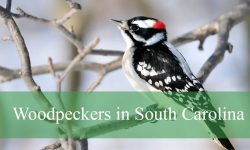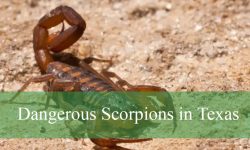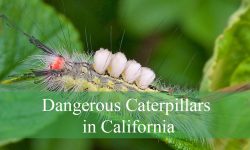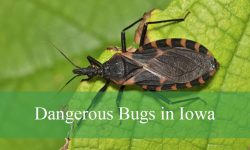Wisconsin is home to a variety of stinging insects, from buzzing yellowjackets to calm honey bees and solitary mud daubers. While many of these species play essential roles in pollination and pest control, their stings can range from mildly irritating to dangerously painful. Understanding which insects pose the greatest threat is key to staying safe outdoors.
Each species has unique traits—some live in large colonies and defend their nests aggressively, while others sting only when handled. Learning how to identify them can help you avoid encounters, protect your home, and enjoy the state’s natural beauty without unwanted surprises.
In this guide, we’ll explore the most dangerous stinging insects in Wisconsin, including how to recognize them, where they live, and what to do if you get stung. You’ll also find safety tips and answers to the most common questions about stinging insects in the Badger State.
Types of Dangerous Stinging Insects in Wisconsin
Yellowjackets
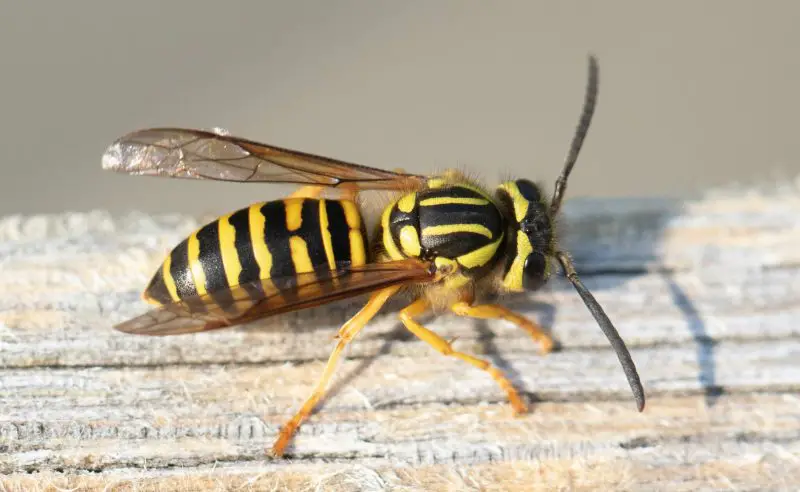
Yellowjackets are among the most aggressive stinging insects found in Wisconsin. These wasps are easily recognized by their bold black and yellow bands and smooth, shiny bodies. Adults typically measure around 0.5 inches long, making them slightly smaller than hornets but faster in flight. Their streamlined shape allows them to maneuver quickly when defending their nests or foraging for food.
These wasps often build nests underground, in wall cavities, or inside tree stumps. The nests are made of paper-like material created from chewed wood fibers mixed with saliva. They become most active during late summer and early fall when their colonies are largest. Yellowjackets are attracted to sugary foods, meats, and open trash cans, which often brings them into contact with people.
Behaviorally, yellowjackets are social insects that live in colonies containing thousands of workers. They are highly territorial and will defend their nests aggressively. Unlike honey bees, yellowjackets can sting multiple times, injecting venom through a smooth stinger without dying afterward. Their stings are extremely painful and can cause swelling, redness, and a burning sensation.
Their venom contains a mix of allergens and toxins that can trigger severe allergic reactions in sensitive individuals. In some cases, repeated stings or multiple attacks can lead to anaphylaxis, requiring immediate medical attention. For most people, however, symptoms subside after a few hours or days with proper care.
Yellowjackets prefer warm, sunny environments and are most active in open areas like gardens, picnic sites, and parks. To avoid stings, it’s best to stay clear of visible nests and cover food outdoors. Controlling food waste and sealing garbage cans can also reduce their presence near human activity.
Bald-Faced Hornets
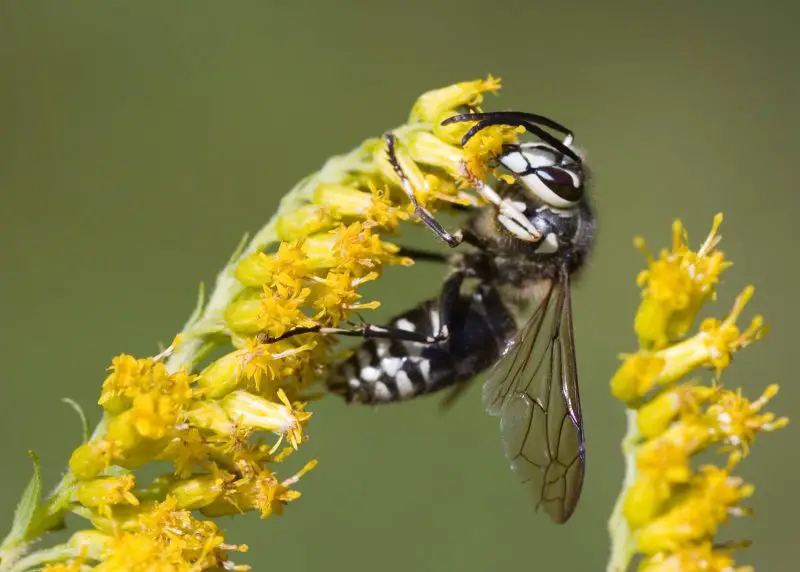
Bald-faced hornets are large, striking insects known for their black bodies and white faces. Despite their name, they are technically a type of yellowjacket rather than a true hornet. Adults grow up to 0.75 inches long, making them one of the largest stinging wasps in Wisconsin. Their powerful wings and distinct coloration make them easy to identify even from a distance.
These hornets build large paper nests that can reach the size of a basketball. The nests are typically suspended from tree branches, bushes, or building eaves. Inside, the queen lays eggs that develop into workers responsible for defending the colony and collecting food. Colonies usually peak in late summer before dying off in fall, except for new queens that overwinter.
Bald-faced hornets are aggressive defenders of their nests and will attack anyone who gets too close. They can sting repeatedly, delivering venom that causes sharp pain and swelling. The stinger injects acetylcholine and histamine-like compounds that trigger burning and itching sensations. In severe cases, multiple stings can lead to dizziness, nausea, or allergic reactions.
Their venom is potent but rarely life-threatening unless a person is allergic. Reactions usually include local pain, redness, and minor swelling. However, unlike bees, hornets can sting several times in succession, making an attack from a swarm extremely painful. The best way to avoid them is to stay at least 10–15 feet away from a visible nest.
Bald-faced hornets thrive in wooded areas, parks, and suburban neighborhoods with trees and shrubs. They feed on nectar, fruit, and other insects such as flies and caterpillars. Despite their aggression, they play an important ecological role by controlling pest insect populations in their environment.
Paper Wasps
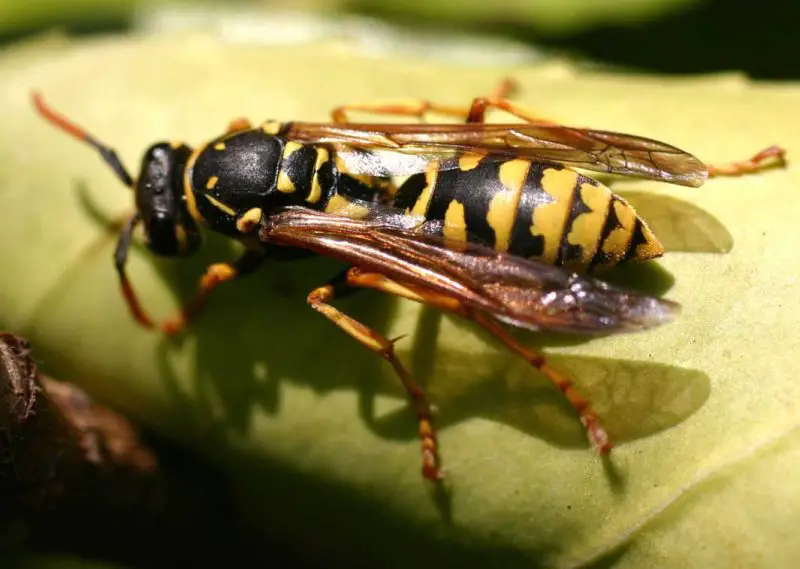
Paper wasps are slender, elegant wasps with long legs and narrow waists. They are usually brown or reddish with yellow markings, measuring about 0.6 to 0.8 inches in length. Their dangling legs during flight make them easily recognizable compared to other wasps. These wasps are less aggressive than yellowjackets or hornets but will sting if they feel threatened.
They build open, umbrella-shaped nests made of grayish paper material under eaves, decks, or railings. Each nest contains several hexagonal cells exposed to view, housing larvae that are fed by adult wasps. Colonies are relatively small, usually containing 20–100 individuals at most. The nests are often reused or rebuilt each spring by a new queen.
Paper wasps are beneficial predators that feed on caterpillars and other soft-bodied insects, helping to keep garden pests in check. They also visit flowers for nectar, contributing to limited pollination activity. However, their tendency to nest near homes or doorways can lead to accidental encounters and painful stings.
Their sting is sharp and immediate, causing localized pain, swelling, and redness. The venom is less potent than that of hornets but can still trigger allergic reactions in sensitive individuals. Unlike honey bees, paper wasps can sting multiple times without losing their stinger.
Paper wasps prefer warm, sheltered locations and are most active during the summer months. They are common around homes, gardens, and parks in Wisconsin. Regular inspection and early nest removal in spring can help prevent infestations and reduce the risk of being stung.
Mud Daubers
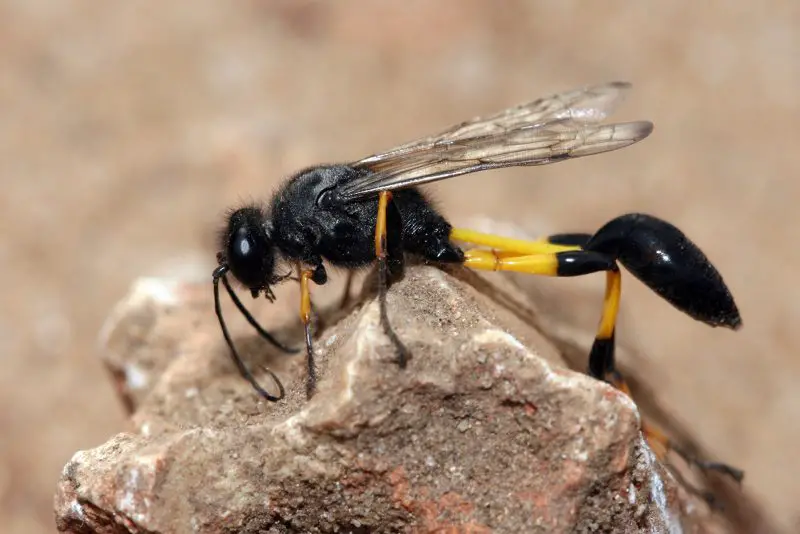
Mud daubers are solitary wasps known for their slender, thread-like waists and long bodies. They come in metallic blue-black or yellow-and-black varieties, measuring around 1 inch in length. Unlike social wasps, they do not live in colonies, making them much less aggressive toward humans.
These wasps build distinctive mud nests on walls, under eaves, and in sheds or garages. Each nest consists of several tube-like chambers created from moist soil. Inside, the female stores paralyzed spiders as food for her larvae. Once sealed, the nest provides a safe environment for developing young.
Mud daubers are gentle by nature and rarely sting unless directly handled or threatened. Their venom is designed to paralyze prey rather than defend against predators. For this reason, their stings are uncommon and generally mild, causing only minor irritation.
They are valuable for natural pest control since they capture and immobilize spiders. Gardeners often appreciate their presence as they help regulate spider populations around homes and outdoor structures. Mud daubers spend most of their time hunting rather than defending nests.
Mud daubers prefer sunny, dry environments with access to mud and nearby water sources. They are common in rural and suburban Wisconsin, often seen flying slowly around barns, garages, and sheds. Their quiet, non-aggressive behavior makes them one of the least threatening stinging insects in the region.
Carpenter Bees
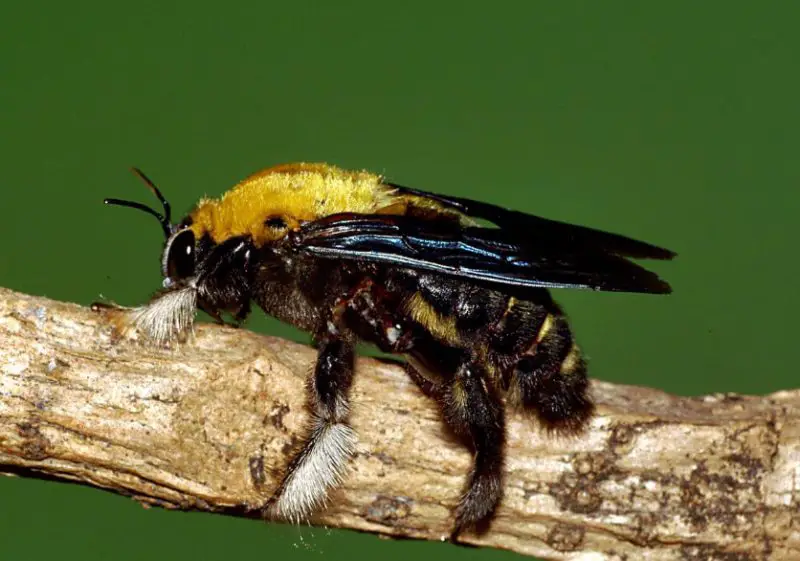
Carpenter bees are large, robust insects resembling bumblebees but with shiny, hairless abdomens. Adults measure between 0.7 and 1 inch long and have a distinctive buzz during flight. Males often hover near nesting sites while females do most of the drilling and nest-building.
These bees get their name from their habit of boring perfectly round holes into wood. They create tunnels in decks, fences, beams, and other wooden structures to lay eggs. Over time, repeated nesting can weaken wood surfaces, making them a nuisance for homeowners.
Carpenter bees are generally non-aggressive. Males, which lack stingers, may act territorial by buzzing close to intruders but cannot sting. Females can sting but rarely do unless handled directly. Their venom is mild, and stings cause short-lived pain and swelling.
They are important pollinators, visiting flowers to collect nectar and pollen. Despite their nesting habits, carpenter bees play a valuable role in the ecosystem. Controlling them involves sealing old holes and painting or varnishing exposed wood surfaces.
Carpenter bees thrive in warm, sunny locations, especially where untreated wood is available. They are widespread across Wisconsin, especially around gardens, wooden homes, and forest edges. Encouraging their pollination activity while managing structural damage strikes the best balance for coexistence.
Honey Bees
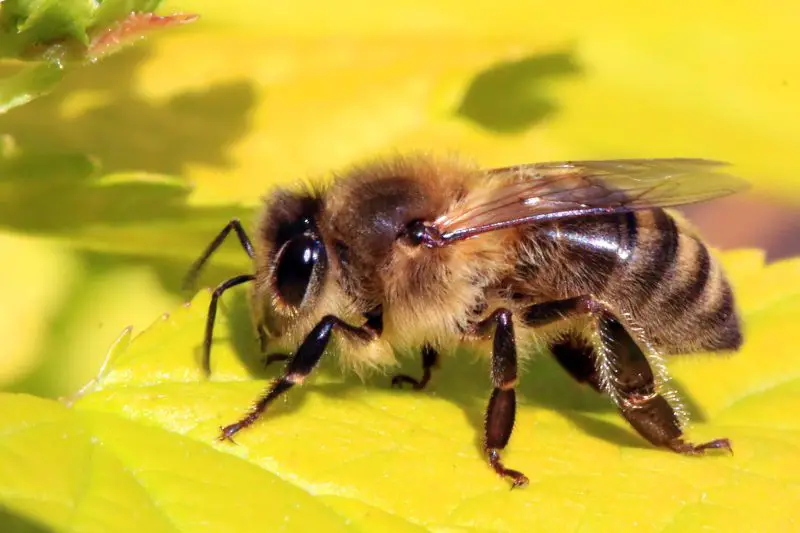
Honey bees are among the most familiar and beneficial insects in Wisconsin, known for their golden-yellow and brown bodies covered in fine hairs. They typically measure about 0.5 inches long and have a fuzzy appearance that aids in collecting pollen. Their distinctive buzzing sound and calm flight pattern make them easy to identify. These bees play a crucial role in pollination and honey production, making them essential for both agriculture and natural ecosystems.
They live in highly organized colonies consisting of a queen, workers, and drones. Honey bee hives can house tens of thousands of individuals, each performing specific tasks such as foraging, brood care, and hive defense. Wild colonies are often found inside hollow trees or abandoned structures, while managed hives are kept in apiaries across the state.
Honey bees are generally gentle and non-aggressive unless provoked or when defending their hive. Their stings occur primarily when they feel threatened or their colony is disturbed. The stinger is barbed and remains lodged in the victim’s skin, causing the bee to die shortly after stinging. This unique mechanism ensures venom delivery but costs the bee its life.
The venom contains melittin, a compound that causes pain, redness, and swelling at the sting site. For most people, these symptoms subside within a few hours. However, in allergic individuals, even a single sting can trigger severe reactions such as hives, dizziness, or anaphylaxis, requiring immediate medical attention.
Honey bees thrive in gardens, meadows, orchards, and agricultural fields throughout Wisconsin. They are most active during spring and summer when flowers are abundant. To avoid stings, it’s best to remain calm around them, avoid swatting, and steer clear of hive entrances or areas with heavy bee activity.
Asian Needle Ants
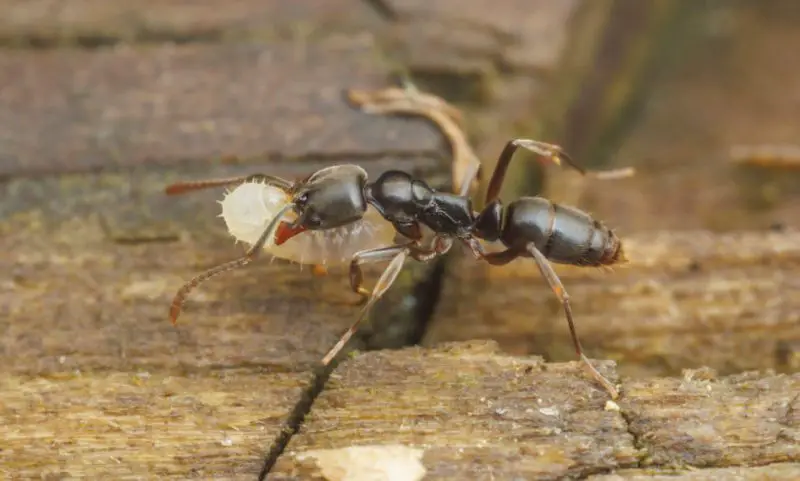
Asian needle ants are invasive stinging ants that have recently been reported in Wisconsin and other parts of the Midwest. They are small, measuring about 0.15 to 0.2 inches long, with dark brown to black bodies and amber-colored legs. Their slender, pointed abdomens give them the “needle” name, and they are often mistaken for native ant species until disturbed.
These ants prefer moist, shaded habitats such as forest floors, rotting logs, mulch, and beneath stones. They often nest close to homes, especially in gardens, basements, or shaded yards. Colonies are relatively small compared to other invasive ants, but their spread can be rapid, displacing native species and disrupting ecosystems.
Asian needle ants are not aggressive unless handled or trapped, but their stings can be extremely painful. They inject venom through a small, sharp stinger at the tip of the abdomen. Victims often experience an intense burning sensation followed by redness and swelling. In some cases, stings can trigger allergic reactions similar to those caused by wasps or bees.
Their venom contains alkaloid toxins that can cause lasting discomfort and hypersensitivity in sensitized individuals. Multiple stings are rare, as these ants do not swarm aggressively like fire ants. However, people who are allergic to insect venom should treat any sting seriously and monitor for signs of anaphylaxis.
Asian needle ants thrive in warm, humid areas and are most active during late spring and summer. Their presence around homes can be minimized by keeping mulch dry, sealing foundation cracks, and maintaining tidy outdoor spaces. Pest control may be required if colonies establish near living areas.
Northern Black Widow Spider
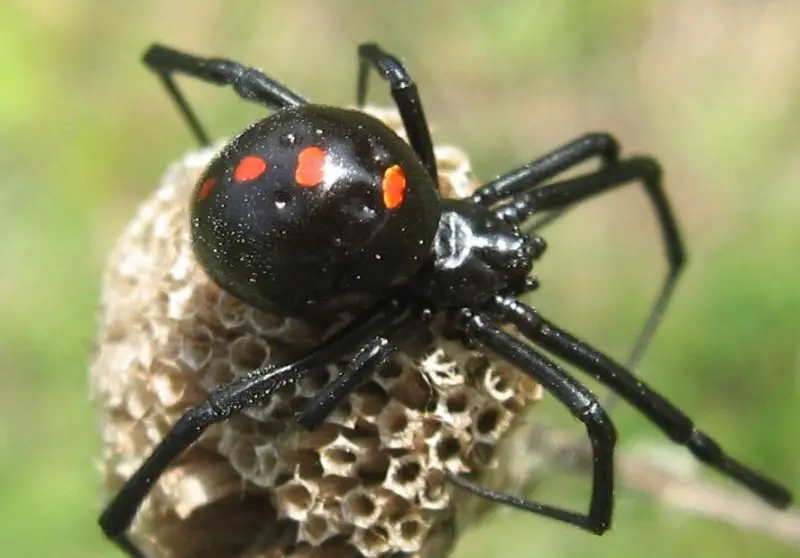
The northern black widow is one of the few venomous spiders found in Wisconsin. It is instantly recognizable by its glossy black body and red or orange hourglass marking on the underside of its abdomen. Females are about 0.5 inches long, while males are smaller and lighter in color. Their long, thin legs and distinctive sheen make them easy to identify in dark corners or cluttered spaces.
These spiders prefer sheltered, undisturbed habitats such as woodpiles, sheds, basements, and stone walls. They build irregular, tangled webs close to the ground where they trap insects and other small prey. Northern black widows are shy by nature and bite only when pressed or disturbed.
A black widow’s venom is neurotoxic, containing latrotoxin, which affects the nervous system. A bite often begins as a pinprick but can develop into intense pain, muscle cramps, sweating, and nausea within an hour. While deaths are extremely rare, bites can be serious and require medical attention, particularly for children or elderly individuals.
Their venom is about 15 times stronger than that of a rattlesnake by weight, though the spider injects only a small amount. The effects can last several hours to a few days, depending on the person’s sensitivity and the amount of venom delivered. First aid typically includes cleaning the wound, applying ice, and seeking medical care if symptoms worsen.
Northern black widows are uncommon in Wisconsin but have been recorded in southern and central regions. They are most active during warm months, typically from May through September. Keeping woodpiles away from homes and wearing gloves when handling outdoor materials helps reduce the risk of encounters.
Brown Recluse Spider
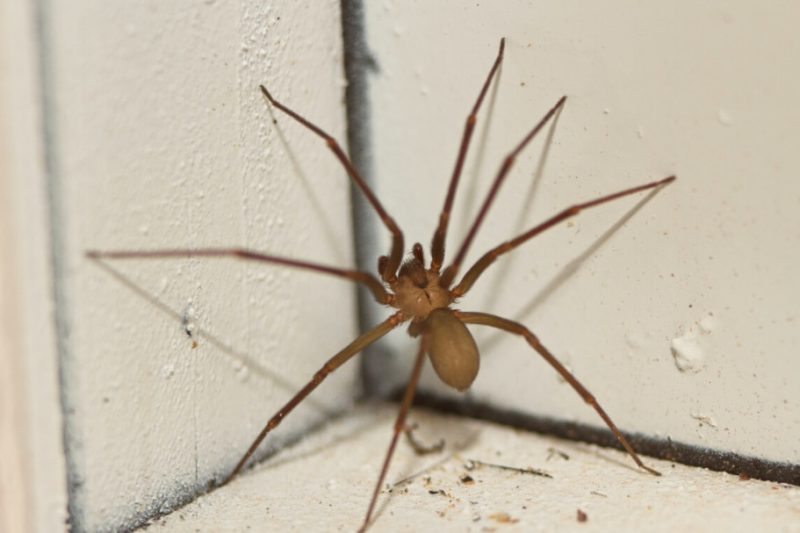
The brown recluse spider is another venomous species occasionally found in Wisconsin, though it is not native to the state. It can be identified by its light brown color and the distinctive dark violin-shaped marking on its back. Adults measure about 0.3 to 0.5 inches in body length, with long, thin legs that give them a delicate appearance.
Brown recluses prefer dark, dry, and undisturbed areas such as basements, closets, attics, and behind furniture. They are nocturnal hunters that feed on insects and other small arthropods. During the day, they hide in crevices or under objects, emerging at night to hunt or mate.
These spiders are not aggressive and typically bite only when trapped against the skin, such as in clothing or bedding. The initial bite is often painless, but venom effects can develop over several hours. The venom contains enzymes that destroy tissue, potentially causing necrotic skin lesions that take weeks to heal.
In most cases, bites result in mild pain, redness, and localized swelling. Severe reactions are uncommon but can include fever, fatigue, and open sores that require medical treatment. Cleaning the bite area and applying ice can help reduce swelling while awaiting medical evaluation.
Brown recluses are rarely encountered in Wisconsin, but occasional sightings occur when goods or furniture are transported from southern states. Maintaining clean, clutter-free storage areas and sealing gaps or cracks helps prevent them from settling indoors.
Tips to Stay Safe from Stinging Insects in Wisconsin
Avoid Disturbing Nests
Never try to knock down or spray a wasp or hornet nest yourself, especially during the day when insects are most active. Keep a safe distance, and contact a pest control professional if a nest is near your home, porch, or children’s play area.
Keep Food and Drinks Covered Outdoors
Stinging insects such as yellowjackets and honey bees are attracted to sweet beverages, fruit, and barbecue foods. Always cover food and drinks when eating outside, and clean up spills or leftovers promptly. Use sealed containers to avoid attracting pests.
Wear Protective Clothing
When gardening, mowing the lawn, or working outdoors, wear long sleeves, pants, and closed-toe shoes. Light-colored clothing is less attractive to stinging insects than dark or floral patterns. Avoid using strong perfumes or scented lotions that can attract bees and wasps.
Stay Calm Around Bees and Wasps
If a stinging insect flies near you, stay calm and move away slowly. Swatting or making sudden movements can trigger defensive behavior. Most bees and wasps will not sting unless they feel cornered or provoked.
Seal Entry Points Around Your Home
Inspect your home for cracks, gaps, or holes where insects can enter. Seal openings in walls, siding, vents, and roof eaves. Keep windows and doors screened to prevent insects from nesting indoors or in attics.
Handle Trash Carefully
Use trash cans with tight-fitting lids and empty them regularly. Avoid leaving sugary drinks, soda cans, or food waste uncovered. Yellowjackets and wasps often scavenge in garbage areas, especially during late summer.
Be Cautious in High-Risk Areas
Watch for increased insect activity around flowers, fruit trees, compost bins, and wooden structures. Wear gloves when reaching into shrubs, storage boxes, or woodpiles—these are common hiding spots for hornets and spiders.
Teach Children to Stay Away
Educate children about not touching insects, nests, or hives. Encourage them to observe from a distance and to tell an adult if they spot a nest near play areas. Awareness can prevent accidental stings and bites.
Know How to Respond to a Sting
If stung, move away from the area to avoid multiple stings. Remove the stinger if visible (in the case of a bee) by scraping it with a card or fingernail—don’t pinch it. Wash the site, apply ice to reduce swelling, and use an over-the-counter antihistamine for itching.
10. Seek Medical Attention for Allergic Reactions
If you experience symptoms like difficulty breathing, dizziness, swelling of the throat, or rapid heartbeat, seek emergency medical help immediately. People with known allergies should always carry an epinephrine auto-injector (EpiPen) during outdoor activities.
FAQs About Dangerous Stinging Insects in Wisconsin
What are the most dangerous stinging insects in Wisconsin?
The most dangerous stinging insects in Wisconsin include yellowjackets, bald-faced hornets, paper wasps, honey bees, and Asian needle ants. These insects can deliver painful stings and, in some cases, cause severe allergic reactions. Spiders like the northern black widow and brown recluse are also venomous and should be treated with caution, even though they are less frequently encountered.
When are stinging insects most active in Wisconsin?
Stinging insects are most active during the warmer months, typically from late spring through early fall. Activity peaks in July and August when colonies are at their largest and food sources are abundant. During this time, it’s important to be cautious around gardens, outdoor eating areas, and wooded spaces.
What should I do if I get stung?
If you are stung, quickly move away from the area to avoid additional stings. Clean the sting site with soap and water, apply a cold compress to reduce swelling, and take an antihistamine if itching occurs. Seek medical attention immediately if you experience symptoms such as difficulty breathing, dizziness, hives, or swelling of the face and throat—these may indicate an allergic reaction (anaphylaxis).
How can I identify a yellowjacket or hornet nest?
Yellowjackets often build nests underground, inside walls, or in tree stumps, while bald-faced hornets construct large, round paper nests hanging from branches or building eaves. Paper wasps make smaller umbrella-shaped nests with open cells, usually under decks, railings, or eaves. Observing their flight patterns and nest locations from a safe distance is the best way to identify them.
Are honey bees aggressive?
Honey bees are generally gentle and will sting only when they feel threatened or when defending their hive. Unlike wasps, they can sting only once because their barbed stinger remains lodged in the skin. If you encounter a hive, remain calm, move slowly, and avoid swatting—sudden movements can provoke defensive behavior.
Can ant stings be dangerous?
Yes. The invasive Asian needle ant found in Wisconsin has a painful sting that can cause swelling and, in rare cases, allergic reactions. While these ants are not as aggressive as fire ants, their venom can be potent enough to cause discomfort and medical complications in sensitive individuals.
Are black widow and brown recluse spiders common in Wisconsin?
Both species are rare in Wisconsin. The northern black widow may appear in southern and central regions, while brown recluse sightings are occasional and often linked to transported goods. Despite their rarity, both spiders have venomous bites that can cause pain, cramps, or tissue damage, so they should not be handled.
How can I prevent stinging insects around my home?
Keep food and drinks covered outdoors, seal trash bins tightly, and inspect for nests early in the season. Repair holes in screens, seal cracks in siding, and keep woodpiles or debris away from the house. For persistent infestations, contact a licensed pest control professional to remove nests safely.
Are stings more dangerous to children and pets?
Yes. Children and pets are more sensitive to venom due to their smaller body size. Stings can cause more pronounced swelling, pain, or allergic reactions. Always monitor them closely after a sting, and seek veterinary or medical help immediately if severe symptoms occur.
When should I call a professional for stinging insects?
If you spot a large nest near entrances, roofs, or high-traffic areas, it’s best to contact a professional. Never attempt to remove hornet or yellowjacket nests on your own, as these insects can attack in groups. A licensed pest control expert has the right equipment and experience to remove them safely and effectively.


